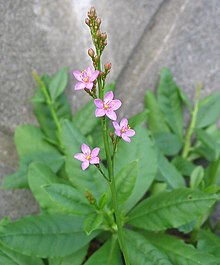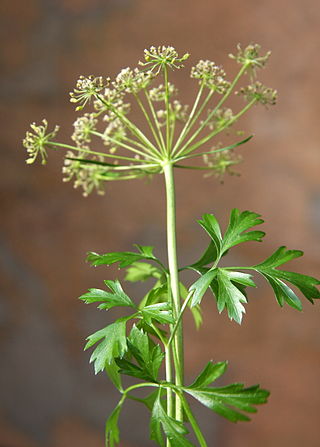
Parsley, or garden parsley is a species of flowering plant in the family Apiaceae that is native to Greece, Morocco and the former Yugoslavia. It has been introduced and naturalized in Europe and elsewhere in the world with suitable climates, and is widely cultivated as a herb, and a vegetable.

Spinach is a leafy green flowering plant native to central and Western Asia. It is of the order Caryophyllales, family Amaranthaceae, subfamily Chenopodioideae. Its leaves are a common edible vegetable consumed either fresh, or after storage using preservation techniques by canning, freezing, or dehydration. It may be eaten cooked or raw, and the taste differs considerably; the high oxalate content may be reduced by steaming.
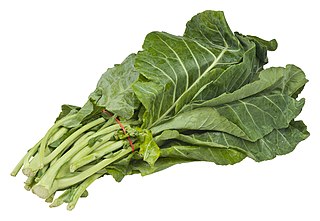
Collard is a group of loose-leafed cultivars of Brassica oleracea, the same species as many common vegetables including cabbage and broccoli. Part of the Acephala (kale) cultivar group, it is also classified as the variety B. oleracea var. viridis.

Chenopodium album is a fast-growing annual plant in the flowering plant family Amaranthaceae. Though cultivated in some regions, the plant is elsewhere considered a weed. Common names include lamb's quarters, melde, goosefoot, wild spinach and fat-hen, though the latter two are also applied to other species of the genus Chenopodium, for which reason it is often distinguished as white goosefoot. Chenopodium album is extensively cultivated and consumed in Northern India, and Nepal as a food crop known as bathua.
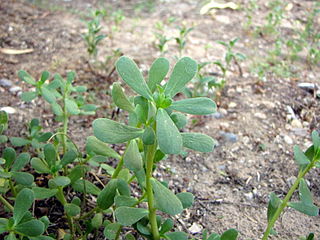
Portulaca oleracea is an annual succulent in the family Portulacaceae.

Leaf vegetables, also called leafy greens, pot herbs, vegetable greens, or simply greens, are plant leaves eaten as a vegetable, sometimes accompanied by tender petioles and shoots. Leaf vegetables eaten raw in a salad can be called salad greens.

Ipomoea aquatica, widely known as water spinach, is a semi-aquatic, tropical plant grown as a vegetable for its tender shoots. I. aquatica is generally believed to have been first domesticated in Southeast Asia. It is widely cultivated in Southeast Asia, East Asia, and South Asia. It grows abundantly near waterways and requires little to no care.

Basella alba is an edible perennial vine in the family Basellaceae. It is found in tropical Asia and Africa where it is widely used as a leaf vegetable. It is native to the Indian subcontinent, Southeast Asia and New Guinea. It is naturalized in China, tropical Africa, Brazil, Belize, Colombia, the West Indies, Fiji and French Polynesia.

Celosia is a small genus of edible and ornamental plants in the amaranth family, Amaranthaceae. Its species are commonly known as woolflowers, or, if the flower heads are crested by fasciation, cockscombs. The plants are well known in East Africa's highlands and are used under their Swahili name, mfungu.

Egusi is the name for the protein-rich seeds of certain cucurbitaceous plants, which, after being dried and ground, are used as a major ingredient in West African cuisine.

Cnidoscolus aconitifolius, commonly known as chaya, tree spinach, or spinach tree, is a large, fast-growing and leafy perennial shrub that is believed to have originated in the Yucatán Peninsula of southeastern México. The specific epithet, aconitifolius, refers to the plant’s "Aconitum-like leaves"—coincidentally, another well-known dangerous, even deadly, genus of plants. As with most euphorbias, the entire plant contains a caustic, viscous and potentially dangerous white sap which flows readily when any part of the plant is broken, cut or damaged.

Moringa oleifera is a fast-growing, drought-resistant tree of the family Moringaceae, native to the Indian subcontinent and used extensively in South and Southeast Asia. Common names include moringa, drumstick tree, horseradish tree, or malunggay.
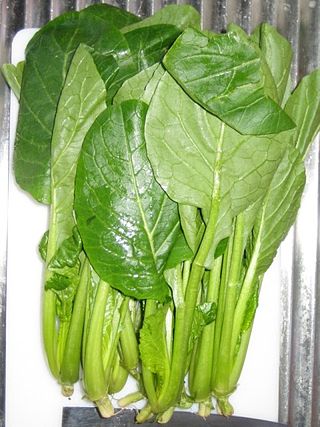
Komatsuna or Japanese mustard spinach is a leaf vegetable. It is a variety of Brassica rapa, the plant species that yields the turnip, mizuna, napa cabbage, and rapini. It is grown commercially in Japan and Taiwan. It is a versatile vegetable that is cooked and eaten in many ways. The plant is also used for fodder in some Asian countries.

Talinum is a genus of herbaceous succulent plants in the family Talinaceae whose common names include fameflower. Several species bear edible leaves, and Talinum fruticosum is widely grown in tropical regions as a leaf vegetable. Talinum paniculatum is grown as an ornamental plant.

Tetragonia tetragonioides, commonly called New Zealand spinach, Warrigal greens and other local names, is a flowering plant in the fig-marigold family (Aizoaceae). It is often cultivated as a leafy vegetable.
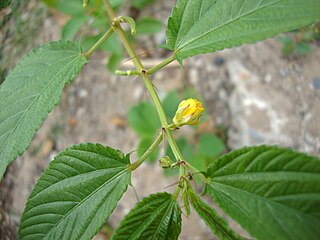
Jute mallow or Nalita jute is a species of shrub in the family Malvaceae. Together with C. capsularis it is the primary source of jute fiber. The leaves and young fruits are used as a vegetable, the dried leaves are used for tea and as a soup thickener, and the seeds are edible.

Nigerian cuisine consists of dishes or food items from the hundreds of Native African ethnic groups that comprises Nigeria. Like other West African cuisines, it uses spices and herbs with palm oil or groundnut oil to create deeply flavored sauces and soups.
Ikot Udo Abia is a village in ward four of the Etinan local government area, Akwa Ibom State, Nigeria. "Ikot Udo Abia" means followers of Udo Abia. The villagers are the Ibibio people who are of the Afaha group within the Iman Clan. The language spoken in the village isIbibio. Ikot Udo Abia lies in the area of Africa which was affected by the Atlantic slave trade of the sixteenth to nineteenth centuries.

Afang soup, is a vegetable soup that originates from the Ibibio People of Akwa Ibom in Southern Nigeria. They share this soup with their neighbors the [Efik] people of [Efik Tribe] in Calabar, Cross River It is a dish popularly known by Nigerians and also some parts of Africa. It is especially popular among the Ibibio and the Anang people of Akwa Ibom and Cross River state who have adopted this cuisine as part of their cultural identity. It's served at homes and also sometimes in ceremonies such as weddings, burials, festivals etc. mostly in the southern part of Nigeria. Afang soup is very nutritious and the cost of preparation can be adaptable based on family needs.
